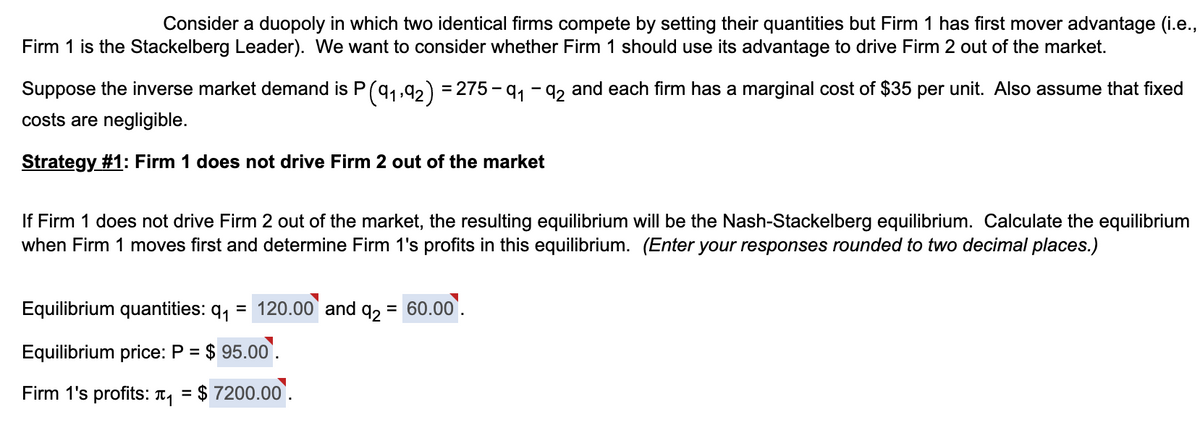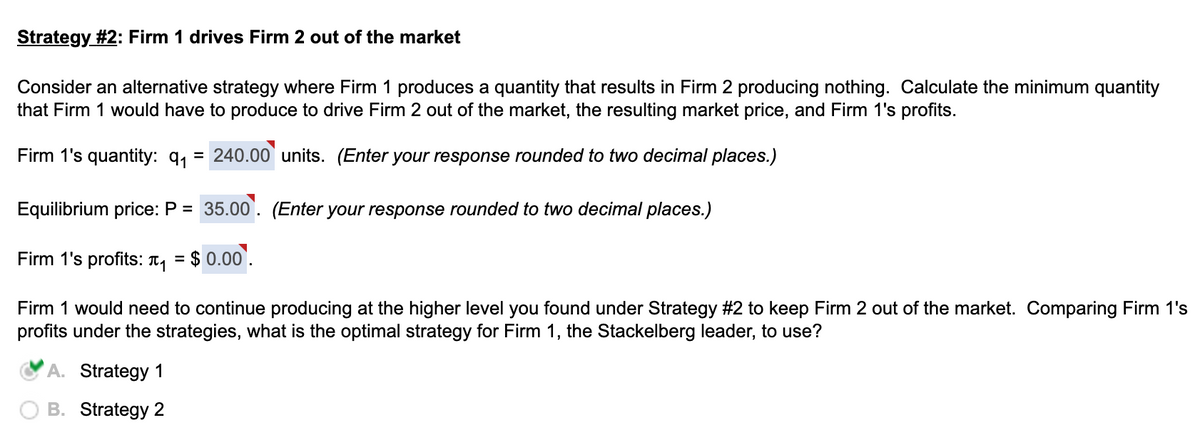Strategy #2: Firm 1 drives Firm 2 out of the market Consider an alternative strategy where Firm 1 produces a quantity that results in Firm 2 producing nothing. Calculate the minimum quantity that Firm 1 would have to produce to drive Firm 2 out of the market, the resulting market price, and Firm 1's profits. Firm 1's quantity: q₁ = 240.00 units. (Enter your response rounded to two decimal places.) Equilibrium price: P = 35.00. (Enter your response rounded to two decimal places.) Firm 1's profits: ₁ = $0.00. Firm 1 would need to continue producing at the higher level you found under Strategy #2 to keep Firm 2 out of the market. Comparing Firm 1's profits under the strategies, what is the optimal strategy for Firm 1, the Stackelberg leader, to use? A. Strategy 1 OB. Strategy 2
Strategy #2: Firm 1 drives Firm 2 out of the market Consider an alternative strategy where Firm 1 produces a quantity that results in Firm 2 producing nothing. Calculate the minimum quantity that Firm 1 would have to produce to drive Firm 2 out of the market, the resulting market price, and Firm 1's profits. Firm 1's quantity: q₁ = 240.00 units. (Enter your response rounded to two decimal places.) Equilibrium price: P = 35.00. (Enter your response rounded to two decimal places.) Firm 1's profits: ₁ = $0.00. Firm 1 would need to continue producing at the higher level you found under Strategy #2 to keep Firm 2 out of the market. Comparing Firm 1's profits under the strategies, what is the optimal strategy for Firm 1, the Stackelberg leader, to use? A. Strategy 1 OB. Strategy 2
Managerial Economics: Applications, Strategies and Tactics (MindTap Course List)
14th Edition
ISBN:9781305506381
Author:James R. McGuigan, R. Charles Moyer, Frederick H.deB. Harris
Publisher:James R. McGuigan, R. Charles Moyer, Frederick H.deB. Harris
Chapter12: Price And Output Determination: Oligopoly
Section: Chapter Questions
Problem 2E
Related questions
Question
Correct answers in the picture. Can someone please provide a solution.

Transcribed Image Text:Consider a duopoly in which two identical firms compete by setting their quantities but Firm 1 has first mover advantage (i.e.,
Firm 1 is the Stackelberg Leader). We want to consider whether Firm 1 should use its advantage to drive Firm 2 out of the market.
Suppose the inverse market demand is P (9₁,92) = 275-9₁-92 and each firm has a marginal cost of $35 per unit. Also assume that fixed
costs are negligible.
Strategy #1: Firm 1 does not drive Firm 2 out of the market
If Firm 1 does not drive Firm 2 out of the market, the resulting equilibrium will be the Nash-Stackelberg equilibrium. Calculate the equilibrium
when Firm 1 moves first and determine Firm 1's profits in this equilibrium. (Enter your responses rounded to two decimal places.)
Equilibrium quantities: q₁ = 120.00 and q₂ = 60.00.
Equilibrium price: P = $95.00.
Firm 1's profits: ₁ = $7200.00.

Transcribed Image Text:Strategy #2: Firm 1 drives Firm 2 out of the market
Consider an alternative strategy where Firm 1 produces a quantity that results in Firm 2 producing nothing. Calculate the minimum quantity
that Firm 1 would have to produce to drive Firm 2 out of the market, the resulting market price, and Firm 1's profits.
Firm 1's quantity: 9₁
= 240.00 units. (Enter your response rounded to two decimal places.)
Equilibrium price: P = 35.00. (Enter your response rounded to two decimal places.)
Firm 1's profits: ₁ = $0.00.
Firm 1 would need to continue producing at the higher level you found under Strategy #2 to keep Firm 2 out of the market. Comparing Firm 1's
profits under the strategies, what is the optimal strategy for Firm 1, the Stackelberg leader, to use?
A. Strategy 1
B. Strategy 2
Expert Solution
This question has been solved!
Explore an expertly crafted, step-by-step solution for a thorough understanding of key concepts.
This is a popular solution!
Trending now
This is a popular solution!
Step by step
Solved in 4 steps

Knowledge Booster
Learn more about
Need a deep-dive on the concept behind this application? Look no further. Learn more about this topic, economics and related others by exploring similar questions and additional content below.Recommended textbooks for you

Managerial Economics: Applications, Strategies an…
Economics
ISBN:
9781305506381
Author:
James R. McGuigan, R. Charles Moyer, Frederick H.deB. Harris
Publisher:
Cengage Learning


Survey of Economics (MindTap Course List)
Economics
ISBN:
9781305260948
Author:
Irvin B. Tucker
Publisher:
Cengage Learning

Managerial Economics: Applications, Strategies an…
Economics
ISBN:
9781305506381
Author:
James R. McGuigan, R. Charles Moyer, Frederick H.deB. Harris
Publisher:
Cengage Learning


Survey of Economics (MindTap Course List)
Economics
ISBN:
9781305260948
Author:
Irvin B. Tucker
Publisher:
Cengage Learning


